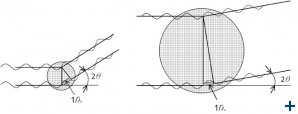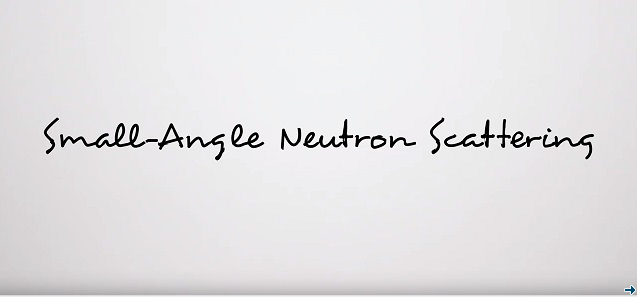Small angle scattering (SANS)
To investigate large structures
SANS enables investigation of micro- and nanostructures between 0,5 nm and 1000 nm. Biomolecules and other polymers, but also filter materials, alloys or catalysts possess differences in density, concentration or magnetisation over the whole sample volume.

SANS: Scattering of two particles of different sizes. Picture courtesy of Aurel Radulescu FRM II / TUM
These differences can be visualised by small angle scattering, since they divert the initially parallel neutron beam in a characteristic way. The result is information about the average particle size and their distribution, but also about shape and chemical structure of nanomaterials. Even fast kinetic processes are accessible by this method.
Case Studies
- Case Study Nanocomposites, HZG. To download PDF file click here.
- Surfactants for stable foam, LLB. To download the PDF file click here.
- Water inside an operating fuel cell
- Improved formulation for Stephan surfactants
- Investigating viscosity to improve product functionality and industrial processing
- Making smarter hydrogels for drug delivery
- Enzyme based detergents and the nanostructure of cellulose fibers
Voiceover for Small Angle Neutron Scattering Video (above)
You want to optimise your products? You need to analyse how your preparations behave? Why not use SANS?
Small Angle Neutron Scattering
SANS lets you to explore the microstructures of liquids and solids in scale ranging from 1 nanometre to one tenth of a micron.
Why is it useful to know their microstructure?
Imagine you want to manufacture a shampoo, with a brand new active molecule. The problem with active molecules is that they are often hydrophobic: they dilute very little in water.
The shampoo is an aqueous preparation that is used beneath water. Therefore, the active molecules are encapsulated in aggregates of surfactants, but the mixture is very liquid and not very practical to use… so a thickener is also added to the mixture – but manufacturers don't want an excessively viscous, glue-like, mixture that is difficult to get out of the bottle.
So, how do you best proportion each ingredient to obtain an attractive shampoo that is stable in a wide temperature range and over time – and which is easy to rinse off. This is when things start to get really tricky. SANS measurements help you optimise your formulation: they let you observe how the molecule in your shampoo are organised.
How does this work?
A product sample is placed in a SANS instrument. The instrument is temperature-controlled and the injection system allows blending if necessary. A beam of neutrons is directed at the sample. The matter of the shampoo deflects some neutrons from their trajectory. A large detector record the positions of these deflected neutrons. The results is curious figures, which the experts will analyse. This measurement makes it possible to determinate the shape, sizes, and spatial organisation of the scatters of structures in your shampoo, ranging from 1 nanometre to one tenth of a micron. It's even possible to detail the size and nature of the lipids layers or bilayers – the barriers that encapsulate the active molecules.
SANS is a major technique, that is also applied to many other systems: polymers, colloids, biological macromolecules, emulsions, pores in solids, aggregates in alloys, and even magnetic microstructures. Available in neutron centres, SANS gives you a novel perspective on the organisation of microstructures.





